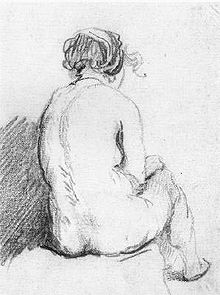Figure drawing
The use of photographic reference—although common since the development of photography—is often criticized or discouraged for its tendency to produce "flat" images that fail to capture the dynamic aspects of the subject.The French Salon in the 19th century recommended the use of Conté crayons, which are sticks of wax, oil and pigment, combined with specially formulated paper.The artist will often start with a graphite pencil to sketch or outline the drawing, then the final line work with a pen or brush, and permanent ink.Some artists draw directly in ink without the preparation of a pencil sketch, preferring the spontaneity of this approach despite the fact that it limits the ability to correct mistakes.An anecdote related by Pliny describes how Zeuxis reviewed the young women of Agrigentum naked before selecting five whose features he would combine in order to paint an ideal image.[4] The use of nude models in the medieval artist's workshop is implied in the writings of Cennino Cennini, and a manuscript of Villard de Honnecourt confirms that sketching from life was an established practice in the 13th century.[4] The Carracci, who opened their Accademia degli Incamminati in Bologna in the 1580s, set the pattern for later art schools by making life drawing the central discipline.[6] "Eighteenth-century drawings, like that attributed to Jacques-Louis David, were usually executed on tinted paper in red or black chalk with white highlights and a darkened ground.In comparison, academies produced in the nineteenth century [...] were typically executed in black chalk or charcoal on white paper and are meticulous depictions of the particularities and idiosyncrasies of the body of the live model.It was not until 1893 that female students were allowed access to life drawing at the Royal Academy in London,[11] and even then the model was required to be partially draped.Academies of fine art in Italy have a scuola libera del nudo ("free school of the nude") which forms part of the degree program but is also open to outside students.The outcomes can be regarded as a finished artwork, expressing both the subject, the observational, emotional and mark making response to the artists figure drawing experience.




Leonardo da Vinciposturesdrawinglive modelfigure studyartistportraitureillustrationsculpturemedical illustrationartist's mannequinperspectiveposturemannequinphotographyskeletonmusculaturegeometricforeshorteningRembrandtFrench SalonContéLovis CorinthcharcoalMatisseWatteauBaroqueRococoHistory of the nude in artAnnibale CarracciZeuxisAgrigentumCennino CenniniVillard de HonnecourtThe CarracciAccademia degli IncamminatiJacques-Louis DavidAcademic artpaintingMichiel SweertsJean Siméon ChardinThomas RowlandsonÉcole des beaux-artsFrançois SalléPedro Américofemale artistsstill lifelandscapeLinda Nochlinfine artAcademies of fine art in ItalyGesture drawingFigure-groundkinesthetic"ideal" figuresArtistic canons of body proportionsCroquisDepictions of nudityNude photography (art)Figure paintingModel (art)University of ConcordiaNudityHistoryPrehistory of nakedness and clothingNakedness and colonialismChildhood nuditySex segregationModestyNudity in religionBreastfeeding in publicPublic bathingFinnish saunaMassageToplessnessTopfreedomCanadaUnited StatesNudity and protestDress codeClothing laws by countryNudity and sexualityIntimate partExhibitionismMooningStreakingStripteaseStripperFeminist stripperVoyeurismAnasyrmaCandaulismIssues in social nuditySexualizationSexual objectificationPornificationIndecent exposureObscenityWardrobe malfunctionStrip searchNaturismNaturist resortChristian naturismFreikörperkulturGay naturismGymnosophySocial nudity organizationsAnarchist naturismTimeline of social nudityNude recreationNude beachNude swimmingNude swimming classesNaked yogaNaked partyNude weddingBy locationAfricaEuropeNorth AmericaSan FranciscoSeattleOceaniaSouth AmericaKurt BarthelLee Baxandall